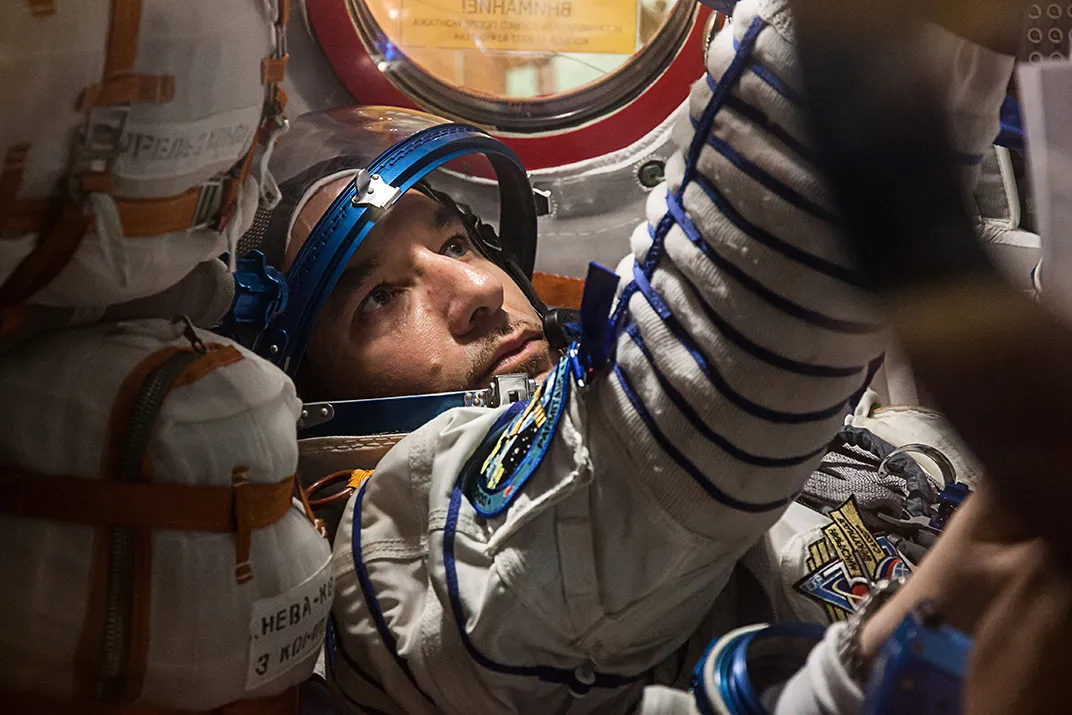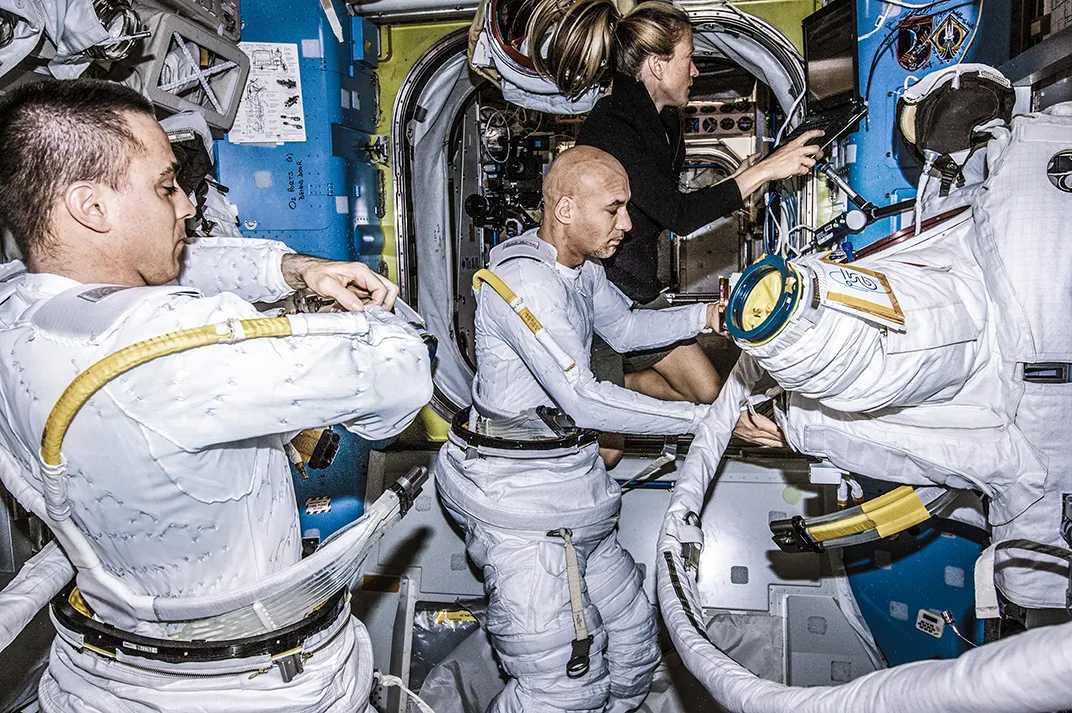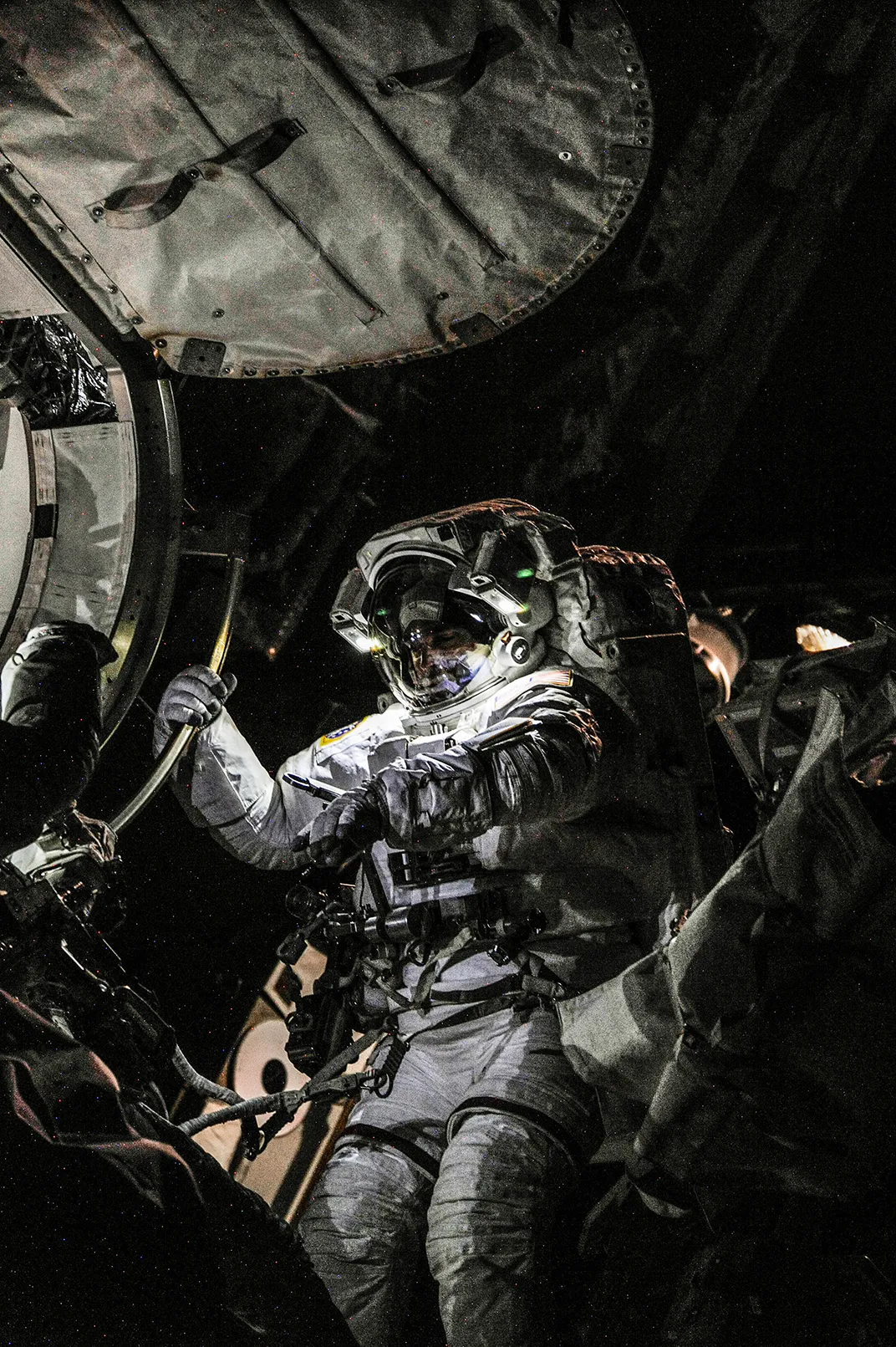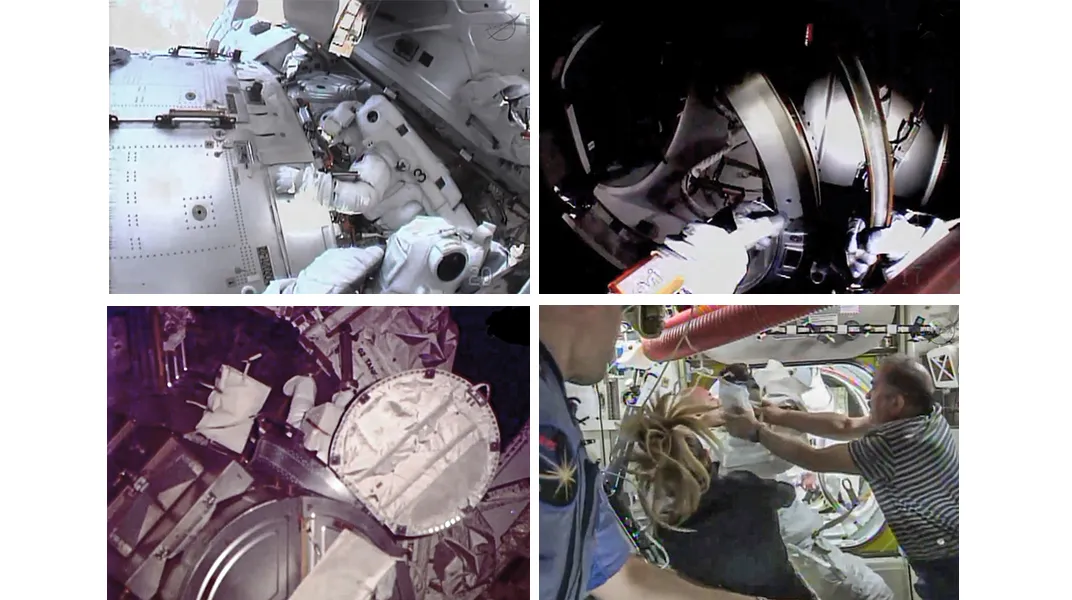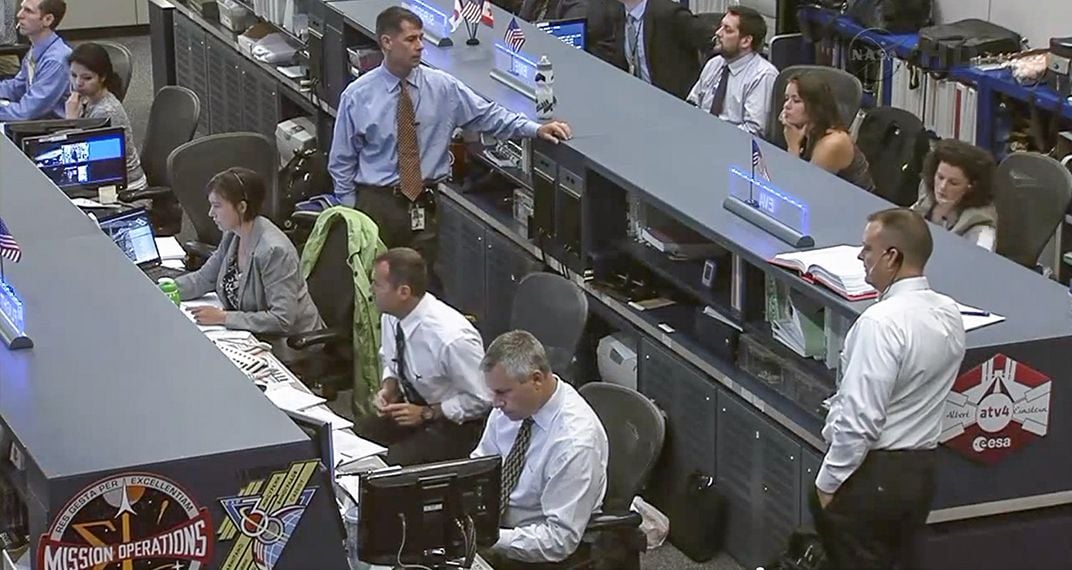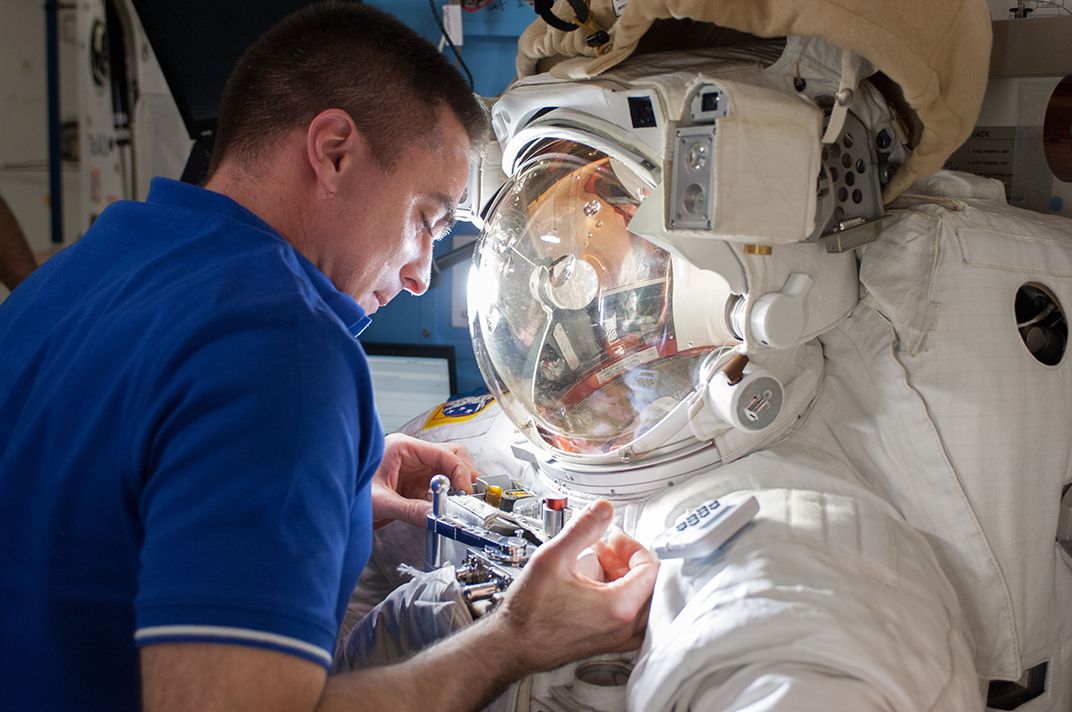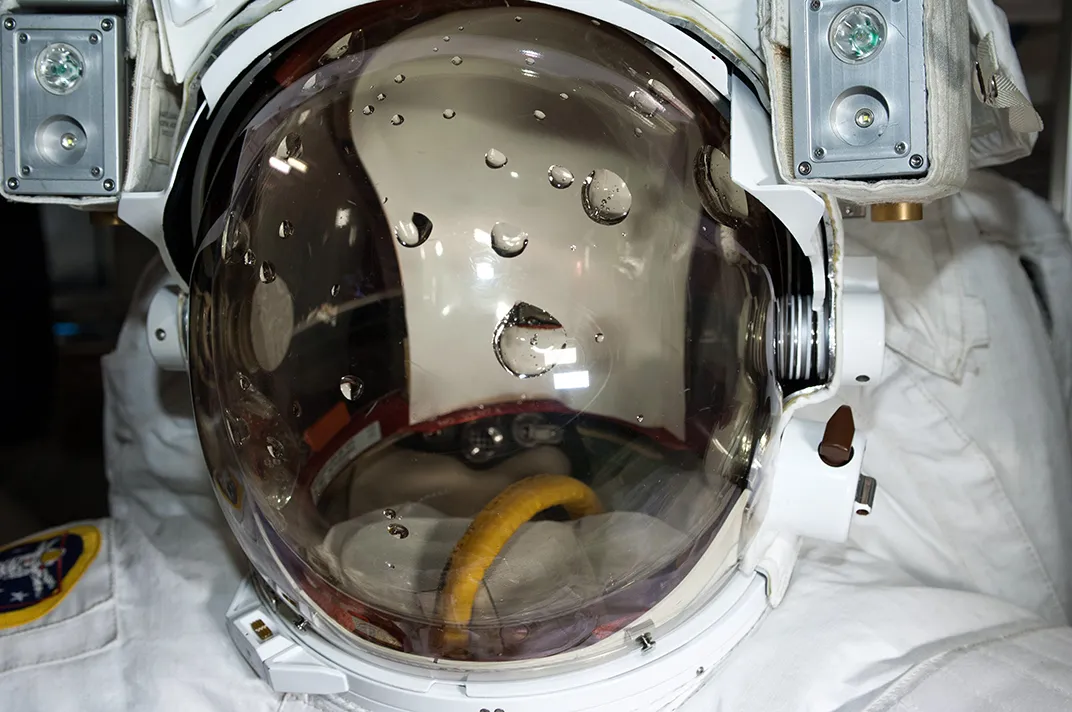The Spacewalk That Almost Killed Him
How Luca Parmitano survived the scariest wardrobe malfunction in NASA history.
/https://tf-cmsv2-smithsonianmag-media.s3.amazonaws.com/filer/6f/5b/6f5b8116-79b6-4310-ac2a-824653fd2864/scariest_spacewalk_hero.jpg)
Chris Cassidy woke on his 43rd morning in space, a Friday, and before even switching on the light in his tiny sleeping quarters, opened his laptop to read the daily report. When he and the five other astronauts on the International Space Station had gone to bed, mission control was pondering a problem: a leak outside the station the astronauts had discovered earlier that day. Russian cosmonaut Pavel Vinogradov had noticed little ammonia snowflakes outside the window sputtering from the cooling system, the space equivalent of a slow drip. Not an emergency, but it would have to be fixed.
Over dinner that night, the astronauts and cosmonauts had discussed their options. Cassidy was of the opinion that NASA would probably wait until he and Italian astronaut Luca Parmitano, who was scheduled to arrive in a couple of weeks, could do an extravehicular activity—NASA parlance for a spacewalk—to assess the problem. Houston ordinarily didn’t like to rush into anything, let alone an EVA. Plus, half the crew was packing up to return to Earth in just four days. That’s why Cassidy couldn’t believe what he now saw on his laptop screen in big red letters: “Welcome to EVA prep day.” He and fellow NASA astronaut Tom Marshburn were going outside—tomorrow.
Rubbing the sleep from his eyes and still in his boxers, Cassidy floated down the dark passage toward the U.S. lab, where Marshburn was already up, having just read the same news. “All I could see was his white teeth smiling,” recalls Cassidy, “and I think he saw the same thing on me. And without saying a word, we high-fived.” They were more than happy to squeeze in another EVA, absolutely. What astronaut wouldn’t be?
As it turned out, the astronauts were able to replace a suspect part on the ammonia pump and in just a few hours were back inside. But spacewalks don’t always run that smoothly, and one was coming that would test two astronauts—and their colleagues on the station and in mission control—with some of the tensest moments in EVA history.
THERE WAS A TIME, not long ago, when spacewalks were considered risky business, almost feared. When NASA was preparing to build the space station in the mid-1990s, some experts didn’t think the agency could safely pull off three or four assembly spacewalks on every shuttle mission, several times a year, for a decade. They called the station’s demanding EVA schedule The Wall, and thought it was insurmountable.
But the wall came down. In the first decade of this century, spacewalks became, if not routine, at least a well-practiced art. Perhaps the most amazing thing about NASA’s EVA record (more than 1,100 hours in the space station era alone) is that there has never been a serious accident. About the worst that astronauts suffer are aching hands, bruises, and the occasional discomfort from some part of the suit digging into their bodies. No spacesuit has ever ruptured in the vacuum. On shuttle mission STS-37 in 1991, a metal rod poked a tiny hole in Jay Apt’s glove, but he didn’t even notice until he came back inside.
Even though spacesickness is a common ailment in orbit, no astronaut has ever vomited in his or her helmet, which would pose a serious risk of choking. Spacewalkers have been known to cough on the water they sip from a drink bag located inside their suits at chest level, but that’s about it. Carlos Noriega was closing out an EVA in 2000 when a sip of water went down the wrong way and he sputtered. A single drop hit his helmet visor, which was coated with a soapy material to prevent fogging, and bounced back into his eye. The soapy droplet stung like crazy, blinding that eye until he could get back inside and remove his helmet. Canadian astronaut Chris Hadfield had the same thing happen on an EVA in 2001, except that it happened to both eyes, and he couldn’t see at all. It took more than half an hour for the tears to evaporate (they don’t fall in zero-G) and the stinging to go away. Hadfield’s vision improved, and he was able to finish the spacewalk.
None of these mishaps turned into full-blown emergencies, though. Even Hollywood’s favorite space disaster scenario—the astronaut drifting off alone, like Sandra Bullock in last year’s Gravity—isn’t much of a risk, thanks to well-drilled procedures in which everything is checked, double-checked, and checked again by your buddy. Spacewalking astronauts are as careful as mountain climbers when it comes to tethering themselves to the station. They have one long safety tether on a spring-loaded reel, plus smaller, supplemental ones, as well as a mini-jetpack called SAFER—the astronaut’s equivalent of a life vest—that can bring them back if the tethers fail. Joe Tanner, a seven-time spacewalker who used to head the astronaut office’s EVA branch and now teaches aerospace engineering at the University of Colorado, can think of only one instance in which somebody—he’d rather not say who—was completely untethered on a spacewalk, and that was just for a few seconds, a momentary lapse in safety so rare he still remembers it years later.
What happened on July 16 therefore came as a surprise, and some participants think it could have ended up worse. “In some ways we got lucky,” says Shane Kimbrough, the astronaut who was in mission control that day talking to spacewalkers Parmitano and Cassidy. Tanner, the veteran EVA chief, says, “I would rank the level of stress for crew members and ground team right up there” with the first space U.S. spacewalk in 1965. Parmitano, he says, “had every right to be fearful for his life.”
***
The youngest person ever assigned to a long-duration space station crew, Parmitano was 36 when he went to space. A former fighter pilot and test pilot in the Italian air force with 2,000 hours in 40 aircraft types, he also is an experienced scuba diver. Born in Sicily, he has an American wife and two young daughters. He is affable and well liked by the NASA astronauts.
By the time Parmitano arrived, last May 29, Cassidy was two months into his second space mission, with four EVAs already to his credit (counting the impromptu spacewalk with Marshburn to fix the ammonia leak). A former Navy SEAL with a master’s degree from MIT, Cassidy has a résumé that stands out even among uber-achieving astronauts. He led a SEAL team to the Zhawar Kili caves in Afghanistan immediately following the 9/11 attacks in 2001, and has two Bronze Stars with a Combat “V.” For all that, there’s little swagger in him; his manner is fairly laid-back. Parmitano says of his EVA partner, “He moves in his spacesuit with an ease and efficiency that is just outstanding. If you watch him, you think This is easy, I can do that. Well, let me tell you, the environment we work in is incredibly harsh. It will kill you if you make mistakes.”
The two of them went outside together for the first time on July 9—a busy EVA to tend to several experiments, relocate some equipment, and do prep work—including routing power and data cables—for the arrival of a new Russian lab module. Everything went smoothly, with only minor problems like a stubborn bolt that took Cassidy a few tries to remove with his power tool. Before emerging from the airlock on his first spacewalk, Parmitano hadn’t been sure how he would react when he looked down at his own feet dangling over Earth 250 miles below. Nobody is sure ahead of time, and some astronauts feel a kind of vertigo and need a few moments to collect themselves before setting to work. But Parmitano loved his six hours outside from the first moment to the last.
A week later, on July 16, they went out again to wrap up some of the tasks from the first EVA and do other maintenance chores. Parmitano exited the airlock’s circular hatch first, hooked his and Cassidy’s 85-foot safety tethers to the station, grabbed a stowage bag full of supplies, and went to a spot not far from the airlock to work on the power and data cables. Cassidy moved along the station’s regularly spaced handrails to another location just above Parmitano—a jumble of cables, connectors, and plumbing lines outside a part of the station’s frame known as the Z1 Truss. Astronauts call this place the Rat’s Nest, and Cassidy set to work finishing up some electrical jumper connections left over from the week before.
Both jobs went faster than expected, and 45 minutes into the spacewalk, the astronauts were a good 40 minutes ahead of schedule. Parmitano had moved on to his next worksite, a crevice where three of the station’s cylindrical modules come together. Here the timeline called for a quick task: He was to reach his arm as far as possible into this tight spot to see how accessible it was, just in case future spacewalkers ever had to work back there.
Parmitano was in the middle of the reach test when he noticed what felt like water at the back of his neck. That was odd. His helmet had a small opening in the back, where breathing air from his suit’s backpack came in. But not water.
Being familiar with the suit design, he knew that water was constantly flowing through the spacesuit’s cooling system—narrow tubes sewn into his long underwear. But that liquid was completely contained, and the reservoir that fed it was deep inside his backpack. It couldn’t be that.
His mind went immediately to the drink bag on his chest. A weird thing had happened at the end of his spacewalk a week earlier. While they were repressurizing the airlock, returning it to a normal space station atmosphere after the air had been vented to match the vacuum outside, he and Cassidy noticed water droplets inside his helmet. At the time they figured his drink bag had leaked somehow. The astronauts talked it over with the ground, and as a precaution, replaced the drink bag in Parmitano’s suit. Could the replacement be acting up too? It didn’t seem likely.
Whatever the cause, “I thought this was really going to be a nuisance,” Parmitano recalls. The worst would be if the water shorted out the microphone or earphones in the “Snoopy cap” through which he talked to Cassidy and mission control. The mike was known to be sensitive to moisture, even sweat, and if the connection became fuzzy, mission control might cut off the spacewalk.
Parmitano knew he should tell Houston. “Shane, FYI,” he called down, addressing Kimbrough, the astronaut capcom on the ground. An experienced spacewalker himself, Kimbrough had been guiding them through the details of the timeline. “I feel a lot of water on the back of my head,” Parmitano reported over the loop. “But I don’t think it’s leaked from my bag.”
Cassidy chimed in: “Are you sweating? You working hard?” From experience, he knew it was important to manage your exertion level on an EVA, to balance exhaled carbon dioxide with inhaled oxygen, keep your body temperature even, and generally try not to overtax the spacesuit’s closed ecosystem. As the lead spacewalker, he also was responsible for his buddy’s safety.
“I am sweating,” Parmitano answered, “but it feels like a lot of water. It’s not going anywhere, it’s just in my Snoopy cap.” He paused, not wanting to sound overly alarmed. In fact, he wasn’t. “Just FYI,” he added, and turned back to his work.
In mission control, Karina Eversley, positioned at a console behind Flight Director David Korth, sat up and took notice. As the lead EVA officer, she was Korth’s point person for anything related to the spacewalk. When she heard Parmitano mention water in the helmet, “immediately it made me think, That’s not normal.” Eversley got on the loop with her spacesuit expert, who was tied in to other engineers in Houston and at the spacesuit manufacturer. Together they worked up a list of questions for Kimbrough to call up to Parmitano. How much water exactly? Where was it coming from?
Inside the space station, NASA astronaut Karen Nyberg also perked up at the first mention of water. She had no duties directly related to the EVA, so she’d been only half-listening to the chatter between the spacewalkers and the ground. After she’d put Cassidy and Parmitano in the airlock to go outside, she had returned to her sleep quarters to answer emails and make a few calls home. Now she started listening more intently to the conversation on the loop.
Cassidy, who’d finished up his work at the Rat’s Nest, traveled the 10 feet or so to where Parmitano was, partly to help with the reach test, but also to see how his partner was doing. He peered inside Parmitano’s helmet, and tapped the visor with his gloved finger. He could see the water, which looked to him like beads of sweat. “It’s not sweat,” said Parmitano. From the ground, Kimbrough asked if it was increasing. “It’s hard to tell, but it feels like a lot of water.” He drank a couple of the floating drops. They tasted awful, metallic—not at all like drinking water.
They continued to talk it over, both in space and on the ground. If the amount of water really was increasing, and it sounded like it was, they’d almost surely have to end the EVA. For Parmitano, it wasn’t a matter of safety—he wasn’t yet concerned about that—but efficiency. He couldn’t keep working like this.
While they were waiting for mission control to make a decision, he and Cassidy used the time to take pictures of each other. It was during this photo session that Parmitano started to appreciate how saturated his cloth Snoopy cap had become. He could feel the water all over his bald head, and strangely, it was cold, much colder than the drinking water.
Kimbrough came back on the line with mission control’s decision: The astronauts were to terminate the EVA and head back in. It wasn’t a full abort, in which “you stop what you’re doing and get your butt back to the airlock right now,” says Cassidy. This would be an orderly retreat. Cassidy would gather up their stuff and secure anything that needed to be secured; they would both head back to the airlock, some 90 feet away. But they would have to separate, since they’d arrived at this spot by different routes, from opposite sides of the Z1 Truss, and they didn’t want their tethers getting tangled.
Cassidy didn’t like having to split up, but there was no choice. “I remember looking at the backside of his spacesuit [as Parmitano turned to leave] and thinking Gosh, I wish I could be with him right now. That’s why we have buddies.” But he figured it would be just a few minutes before they were back together at the airlock.
Parmitano set out first. Initially, he recalls, “it was okay.” He traveled the same path he’d used to exit the station, following his tether around the Z1 Truss, moving from one handrail to the next. Halfway back to the airlock, he came to a protruding antenna boom he had to maneuver around. On every EVA, astronauts are given a list of items to avoid touching. It might be a fragile or hazardous piece of equipment, or a panel with a delicate coating. Even certain handrails are off-limits: those with sharp pits from meteoroid impacts, which, like freshly cut metal, could rip the spacewalkers’ gloves. The antenna was on the list. To navigate around it, Parmitano says, “I had to flip up with my head toward the station and my feet toward the sky.”That’s when things got bad. Whether it was the flipping motion or just his Snoopy cap becoming so saturated that the water had nowhere else to flow, a large blob of liquid moved down, covering Parmitano’s eyes and getting in his nostrils. Now he could breathe only through his mouth, and he couldn’t see clearly through the glob of liquid clinging to his face.
Then the sun went down.
Ordinarily this was no problem—his helmet had a headlight. But in space, with no air to refract the beam, the light illuminated only a small, tight circle directly in front of him. The rest was utter darkness. It was hard enough to tell one handrail from another under normal circumstances. With the water glob, it was almost impossible. He started to realize his Snoopy cap had stopped working, and that nobody could hear him anymore. Since the spacewalk, friends have complimented him for his stoic silence during this time. “I’ve been told that I was cool as a cucumber,” he says. “The truth is that I was trying to talk.”
Even though he couldn’t see, he called on his knowledge of the station’s architecture to get his bearings, and could feel the tug of the spring-loaded tether, telling him he was moving in the right direction. Finally he saw the hatch cover, and light inside. “I’m at the airlock,” he radioed to the ground—a sudden burst of good comm. He floated head-first through the outer hatch. He was back.
***
Inside the station, Karen Nyberg had heard the call to terminate and immediately went to get her Russian crewmates—Pavel Vinogradov, Fyodor Yurchikhin, and Sasha Misurkin. Ordinarily just one of the Russians would have been on hand to help bring U.S. spacewalkers inside, but all of them pitched in, rounding up towels and offering Nyberg help. They were in an equipment room attached to the tiny outer airlock, and could see Parmitano through a little porthole, although they couldn’t see his face.
Cassidy’s anxiety had been building in the several minutes it took him to get back to the hatch himself. He hadn’t heard anything from Parmitano, and when he did finally hear “I’m at the airlock” over the loop, it was followed by some scratchy half-sentence about “a lot of water.”
In order to get Parmitano back inside the station with his helmet off, Cassidy would have to close the outer hatch, followed by several minutes of repressurizing the airlock before they could open the inner hatch to the room where Nyberg and the Russians were waiting.
Ever since the water had covered his nose, Parmitano had been working out a plan in his head. If it moved to his mouth and he could no longer breathe, he would open a purge valve in his helmet to try to let some of the liquid out. As a last-ditch effort, he could even open the helmet. He’d probably pass out, but at least he wouldn’t drown. But that worked only if the airlock were closed. Cassidy had something similar in mind as he struggled with the bulky outer door. “That was my most important job,” he says. “I had the rest of Luca’s life to get the hatch closed.”
The instant he did, Nyberg turned the valve to start repressurizing the airlock. Now it was just a matter of waiting several minutes while it filled with air and the astronauts adjusted to the change in pressure. Still unable to communicate, Parmitano says he “was just waiting for the [repressurization] to end, taking it one second at a time. At that point I’m virtually isolated from a sensory point of view. I can’t hear. I can’t really see. I can’t move. Every time I moved, the water sloshed around.” So he kept as still as possible, trying to keep it from reaching his mouth.
For Flight Director David Korth, 250 miles away in mission control, those last moments in the airlock were the worst. “Time really slowed down a lot at that point,” he says. They hadn’t heard from the distressed astronaut in many long minutes, and Korth was considering telling Nyberg to go to an emergency (much speeded up) repressurization and get Parmitano’s helmet off as quickly as possible. It would probably blow out his eardrums, but it might save his life.
Nyberg didn’t need to hear from the ground. She was having the same thoughts, and was on the verge of reaching for the valve. What stopped her was a simple human gesture: Parmitano squeezed Cassidy’s hand to signal that he was alright.
The two astronauts were crammed into the airlock head-to-foot, like a pair of shoes in a shoebox—the only way two people wearing bulky backpacks can fit in the tight space. Trying to see how Parmitano was doing at the other end, Cassidy had wiggled and contorted himself. “I wanted to see him. I wanted to look in his face.”
He could see that the water was over Parmitano’s eyes “and sort of bouncing around his nostrils. That’s when my senses really got heightened. So I grabbed his hand, just kind of squeezing it. He and I had never talked before that this would be our hand signal if we can’t talk. It just was a natural thing. I grabbed his hand and squeezed it. He squeezed it back, so I knew he was okay.”
Cassidy radioed to the ground. “He looks fine. He looks miserable, but okay.” They could all relax.
It was just a few minutes later that Fyodor Yurchikhin opened the inner hatch and Nyberg and the Russians pulled Parmitano inside, removed his helmet, and started toweling him off. They estimated later that they mopped up a quart and a half of water.
All Parmitano remembers saying is something like “Thanks, guys.”
***
Six months after the EVA, spacesuit engineers still didn’t know the exact cause of the leak, although they quickly discovered which part failed—a fan pump separator that has since been replaced on the suit Parmitano wore, and has already been used on a spacewalk without incident. The engineers also have added a snorkel-like breathing tube to the EVA helmet and spacesuit in case this ever happens again, and an absorbent pad around the top of the head. Lesson learned.
NASA spaceflight people have a euphemism to describe the many fatal accidents, known and unknown, that might conceivably befall them. With a kind of whistling-past-the-graveyard understatement, they call it “having a bad day.”
The best way they know to prevent bad days is to learn from experience, and to train astronauts, in every way they can, to handle every kind of circumstance they can think of. Asked what was the most important factor in his ability to handle his ordeal last July, Parmitano says, “I have a hard time when people say I was cold as ice, that I did such a great job. I have a hard time taking credit for that. What happens is that you get trained. And all the people who contributed to that should take the credit. I followed the route [back to the airlock] because I had studied the station—because somebody on the ground told me to study it.”
A few hours after the spacewalk, Korth and Eversley participated in a press conference in Houston to brief reporters about what had happened. Shortly before meeting the press, the ground team had been sobered to hear Parmitano, in a private teleconference, tell the full story. Until they heard his version, says Kimbrough, “we never really understood how bad it was.”
Eversley opened her statement to the press with “It was a good day today. The crew is inside and safe.” That may have sounded strange to the rest of the world, considering how far off track the EVA had gone. But her colleagues knew just what she meant.
